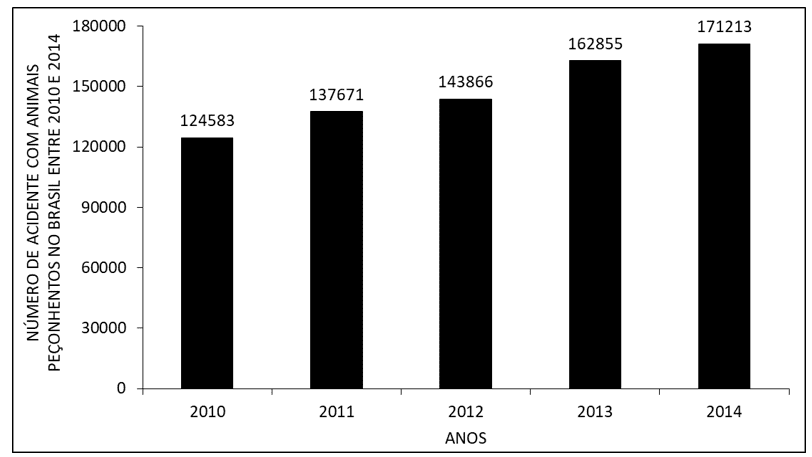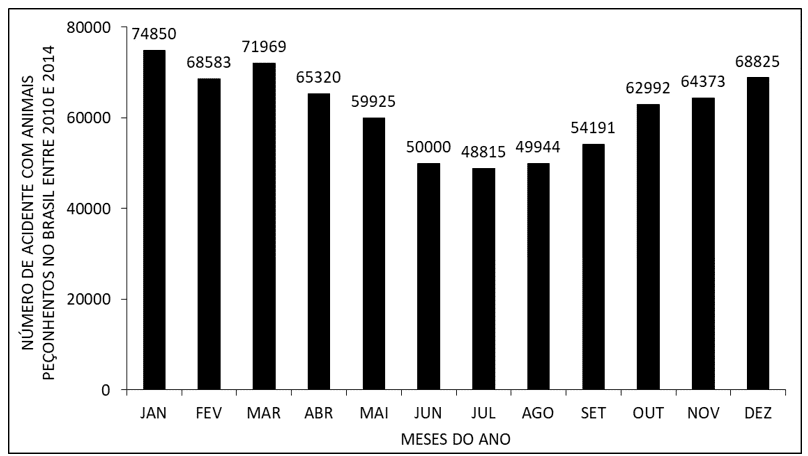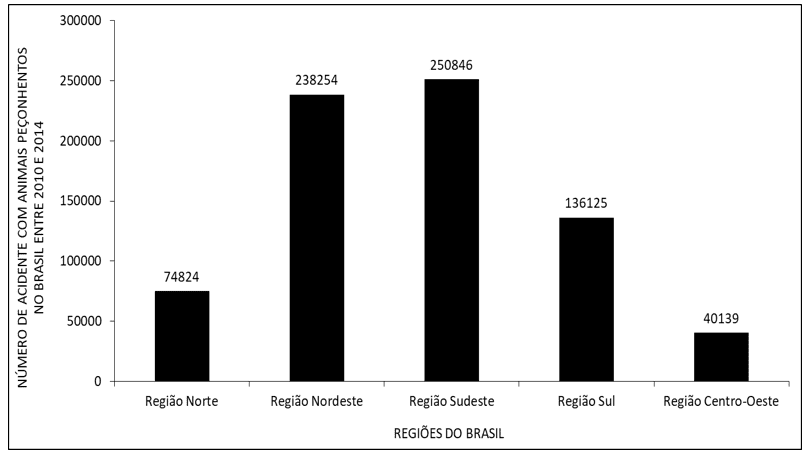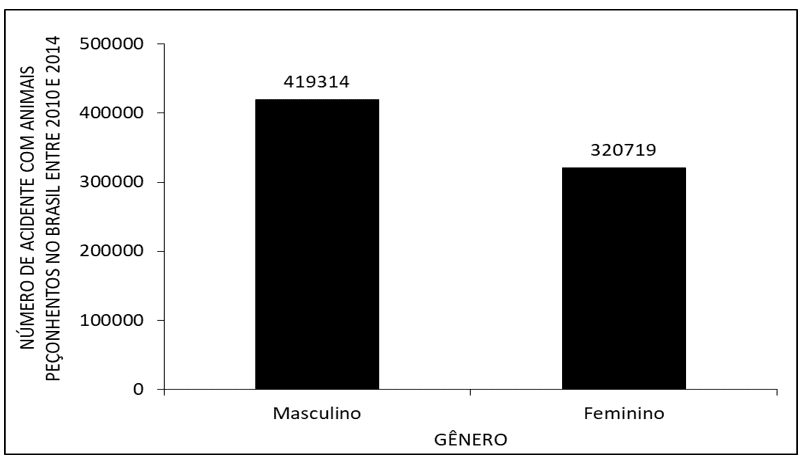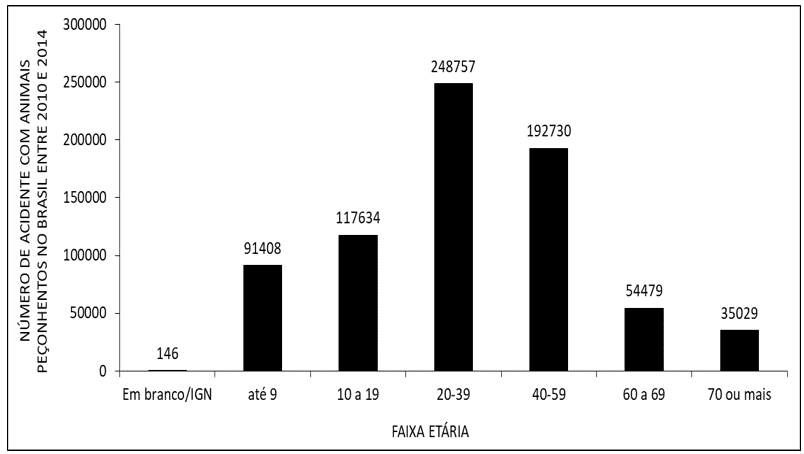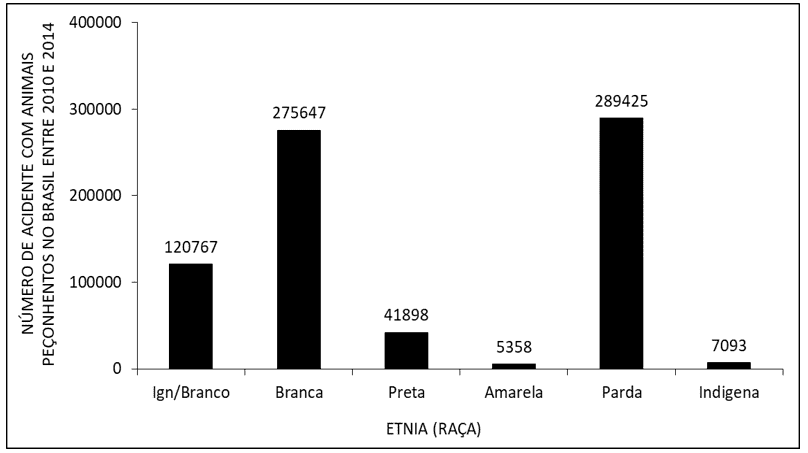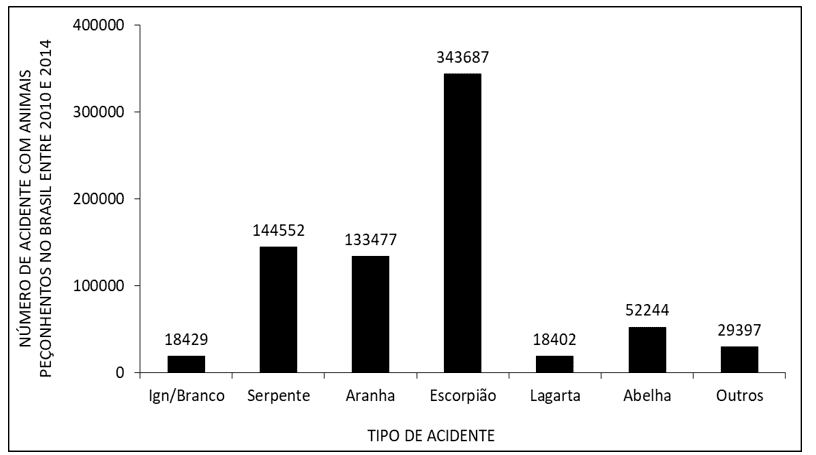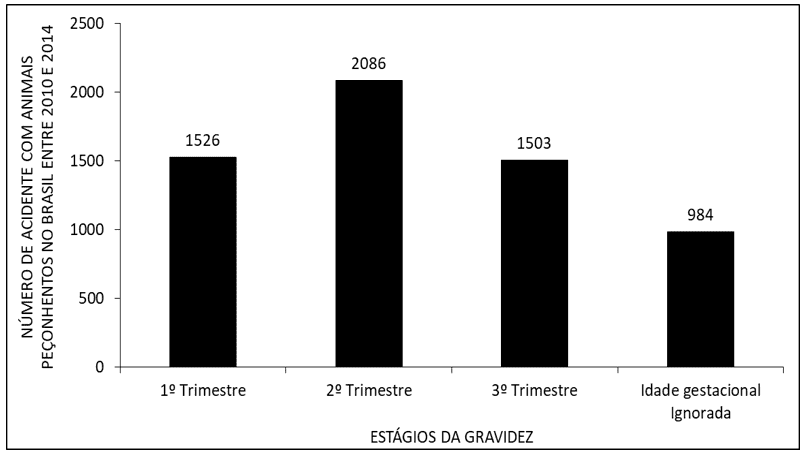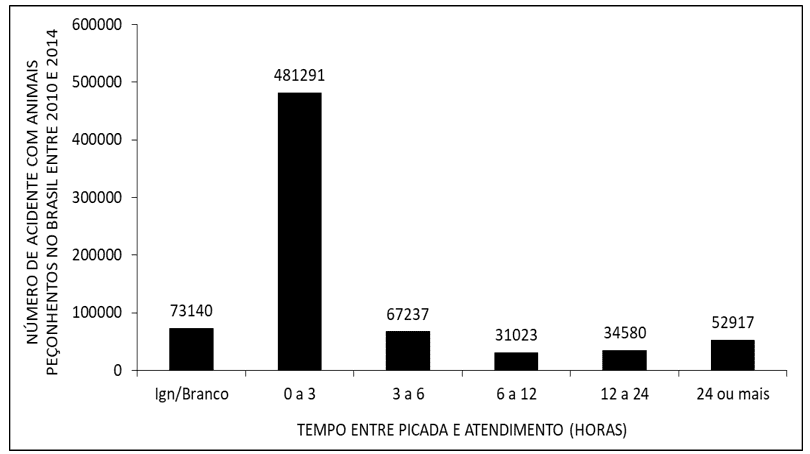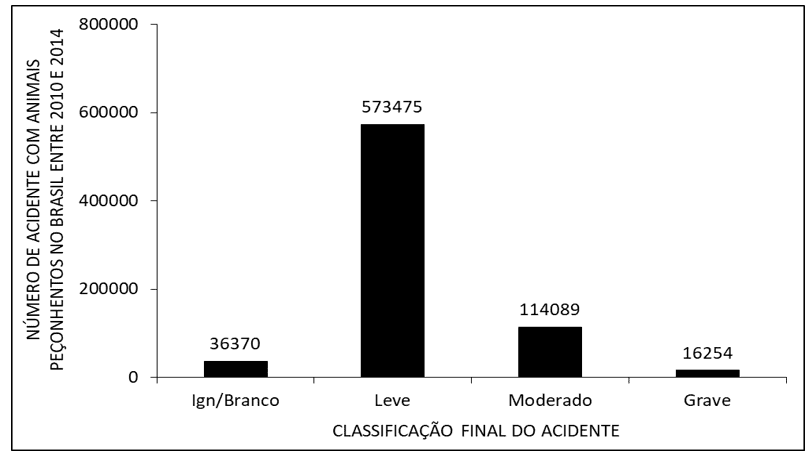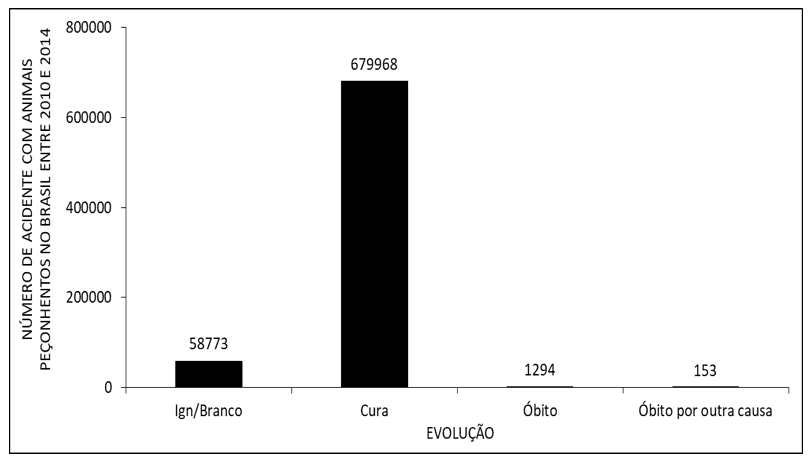ORIGINAL ARTICLE
SOEIRO, Selthon Macello Capiberibe [1], FACCO, Lucas [2], FECURY, Amanda Alves [3], ARAÚJO, Maria Helena Mendonça de [4], OLIVEIRA, Euzébio de [5], DENDASCK, Carla Viana [6], SOUZA, Keulle Oliveira da [7], DIAS, Claudio Alberto Gellis de Mattos [8]
SOEIRO, Selthon Macello Capiberibe. Et al. Number of accidents caused by venomous animals between 2010 and 2014 in Brazil. Revista Científica Multidisciplinar Núcleo do Conhecimento. Year 05, Ed. 12, Vol. 01, pp. 05-17. December 2020. ISSN: 2448-0959, Access Link: https://www.nucleodoconhecimento.com.br/health/number-of-accidents, DOI: 10.32749/nucleodoconhecimento.com.br/health/number-of-accidents
SUMMARY
Venomous animals are those that have a mechanism for injecting poison. Different poisons or venoms can cause pain, rupture of blood vessels, burn, blisters, edemas, necrotic injury, hemorrhage, blood vomit, presence of blood in the urine, bleeding in the nose, intense sweating, low blood pressure, hypothermia and neurological problems. The aim of this article is to show the number of accidents caused by venomous animals between 2010 and 2014 in Brazil. Considered as neglected causes of diseases, accidents caused by venomous animals require greater public health attention. Spiders, scorpions and snakes are the main causators of these accidents. Among children, boys are the most affected, and lack of supervision in daily activities is one of the main causes of this problem. The production of serum for the treatment of odidise accidents in Brazil is accentuated, and the amount produced is able to cover the total number of cases in the country. However, there is a problem regarding the distribution of this serum, since areas of indigenous population and regions of remote localities do not have adequate availability, enabling negative consequences for the individuals in question, increasing the possibility of deaths from this type of accident.
Keywords: Epidemiology, venom, poison.
INTRODUCTION
Venomous animals are those that have a mechanism for injecting poison, which can be stingers, stingers or teeth (Pine and Sparrow, 2015). Some species of bees, snakes, wasps, marimbondos, spiders, scorpions and caterpillars can be considered as venomous animals (BREDT and LITCHTENEKER, 2014; NEIVA, et al., 2019).
Different poisons or venoms can cause pain, rupture of blood vessels, burn, blisters, edemas, necrotic injury, hemorrhage, blood vomit, presence of blood in the urine, bleeding in the nose, severe sweating, low blood pressure, hypothermia and neurological problems (LIMA et al., 2017; NEIVA, et al., 2019).
The treatment of accidents with venomous animals is done, in most cases, by means of an antivenom serum that contains specific antibodies to fight the toxins of each animal, and this should be applied as soon as possible to avoid aggravation of the case (SOUZA and MACHADO, 2017).
To prevent snake accidents, gloves and boots should be used when cleaning bushes, debris, dry leaves, garbage and others, as such animals prefer hot and humid places. You should not put your hands in holes, you should avoid the proliferation of rats, since these are snake food and, in addition, it is necessary to avoid the accumulation of bush, wood, bricks and other materials that can become a shelter for animals that serve as food for snakes (BRASIL, 2001).
To prevent accidents with arachnids, wasteland, gardens and backyards should be keep free of rubble, bushes, dry leaves and building materials, thus preventing them from finding shelter. In addition, one should: avoid plants with dense foliage near walls; shake clothes and shoes before wearing; wear gloves and shoes when handling and walking in places that may contain such animals; seal openings where arachnids can cross (mainly at night, due to their habits); put screens in drains, sinks and tanks; prevent the proliferation of insects that are the food of arachnids (one of the measures is to keep household waste indoors to avoid cockroaches and flies); remove beds from the walls and do not let musketeers and bed sheets touch the floor; avoid killing arachnid predators (frogs, birds, lizards, chickens, geese, monkeys and others) (BRASIL, 2001).
The number of cases in Brazil between 1986 and 2016 was 2,183,989. The number of cases per region in Brazil, between 1986 and 2016, are: North region: 233,586; Northeast region: 624,615; Southeast region: 758,238; South region: 427,442; Midwest region: 140,108. The number of cases in Amapá between 1986 and 2016 in Amapá 8463 (BRASIL, 2017).
GOALS
Show the number of accidents caused by venomous animals between 2010 and 2014 in Brazil.
METHOD
The research was carried out in the DATASUS database (http://datasus.saude.gov.br/). National data were collected according to the following steps: A) The datasus.saude.gov.br link was accessed, the arrow was slid with the mouse to the “Access to Information” tab, and then the “Health Information Information (TABNET)” tab was clicked on “Epidemiological and Morbidity”. The next page clicked on “Diseases and Diseases of Notify – From 2007 onwards (SINAN)”. On the next page we selected “Accidents by Venomous Animals. In the box “Geographic Coverage” we opted for “Brazil by Region, UF and Municipality”. From there followed the steps: A) On the line, “Accident year” was selected; in the “Not active” column, and in the “Notifications” content. All data collected in this and next steps are between 2010 and 2014. B) On the line, “Accident Year” was selected; in the “Accident Month” column, and in the “Notifications” content. C) On the line, “Accident Year” was selected; in the “Notification region” column, and in the “Notifications” content. D) On the line, “Accident Year” was selected; in the “Age group” column, and in the “Notifications” content. E) On the line, “Accident Year” was selected; “Race” column, and in the “Notifications” content. F) On the line, “Accident Year” was selected; “Sex” column, and in the “Notifications” content. G) On the line, “Accident Year” was selected; “Pregnant Women” column, and in the “Notifications” content. H) On the line, “Accident Year” was selected; in the “Time/call” column, and in the “Notifications” content. I) On the line, “Accident Year” was selected; in the “Accident Type” column, and in the “Notifications” content. J) On the line, “Accident Year” was selected; in the “Sorts. “Notifications” content. K) On the line, “Accident Year” was selected; in the “Evolution case” column, and in the “Notifications” content
The data was compiled within the Excel application, a component of the Microsoft Corporation Office suite. The bibliography research was carried out in scientific articles, using computers from the computer laboratory of the Federal Institute of Education, Science and Technology of Amapá, Macapá Campus, located at: Rodovia BR 210 KM 3, s/n – Bairro Brasil Novo. ZIP Code: 68.909-398, Macapá, Amapá, Brazil.
RESULTS
Figure 1 shows the number of accidents caused by venomous animals between 2010 and 2014, indicating an increase each year.
Figure 1 Shows the number of cases of accidents caused by venomous animals in Brazil between 2010 and 2014.
Figure 2 shows the number of accidents caused by venomous animals per month of the year between 2010 and 2014. The largest number occurs in January, showing a fall in February, increasing again in March and again declining until july. This is the month with the lowest number of cases, with an increase in subsequent months.
Figure 2 Shows the number of cases of accidents caused by venomous animals in Brazil between 2010 and 2014, for months of the year.
Figure 3 shows the number of reports of accidents caused by venomous animals in Brazil between 2010 and 2014, by regions of the country. The largest number of cases occurs in the southeast region followed, respectively, by the northeast, south, north and midwest regions.
Figure 3 Shows the number of cases of accidents caused by venomous animals in Brazil between 2010 and 2014, by regions of the country.
Figure 4 shows the number of reports of accidents caused by venomous animals in Brazil between 2010 and 2014, by gender. The largest number of cases happen to men.
Figure 4 Shows the number of cases of accidents caused by venomous animals in Brazil between 2010 and 2014, by gender.
Figure 5 shows the number of reports of accidents caused by venomous animals in Brazil between 2010 and 2014, by age group. The largest number of cases, according to the data, occurs with people between 20 and 39 years old. The second highest number of cases appears in the group between 40 and 59 years.
Figure 5 Shows the number of cases of accidents caused by venomous animals in Brazil between 2010 and 2014, by age group.
Figure 6 shows the number of reports of accidents caused by venomous animals in Brazil between 2010 and 2014, by ethnicity. The largest number of cases occur with people of brown ethnicity, followed by people declared white and black people, respectively.
Figure 6 Shows the number of cases of accidents caused by venomous animals in Brazil between 2010 and 2014, by ethnicity.
Figure 7 shows the number of reports of accidents caused by venomous animals in Brazil between 2010 and 2014, by type of accident. The highest number of cases occurred in accidents involving scorpions.
Figure 7 Shows the number of cases of accidents caused by venomous animals in Brazil between 2010 and 2014, by type of accident.
Figure 8 shows the number of reports of accidents caused by venomous animals in Brazil between 2010 and 2014, according to the stages of pregnancy. The highest number of cases occurs with pregnant women in the second trimester, followed by pregnant women in the first and third trimesters, respectively.
Figure 8 Shows the number of cases of accidents caused by venomous animals in Brazil between 2010 and 2014, according to the stages of pregnancy.
Figure 9 shows the number of reports of accidents caused by venomous animals in Brazil between 2010 and 2014, according to the time in hours between the bite and the service. The data show that the largest number of people is attended between 0 and 3 hours after the accident.
Figure 9 Shows the number of cases of accidents caused by venomous animals in Brazil between 2010 and 2014, according to the time in hours between the bite and care.
Figure 10 shows the number of reports of accidents caused by venomous animals in Brazil between 2010 and 2014, by final classification of the accident. The highest number of cases had as final classification of the accident of mild degree.
Figure 10 Shows the number of cases of accidents caused by venomous animals in Brazil between 2010 and 2014, by final classification of the accident.
Figure 11 shows the number of reports of accidents caused by venomous animals in Brazil between 2010 and 2014, by evolution of the case. The largest number of cases was cured, with a minimum amount dying.
Figure 11 Shows the number of cases of accidents caused by venomous animals in Brazil between 2010 and 2014, due to the evolution of the case.
DISCUSSION
Accidents caused by venomous animals are considered as neglected causes of diseases, and their occurrence is higher in rural areas and in countries whose poverty is widespread. Capable of generating a series of losses, such accidents are capable of causing consequences at the organic and socioeconomic level, since they justify the need for investments in prophylactic methods and sera for the treatment of such involvements (SALOMÃO et al., 2018). Considered as a clinical emergency (i.e., in which there is a need for immediate attention to the patient), they are caused by a series of venomous animals, being scorpions, spiders and snakes. In 2013, in Brazil, there were 158,002 cases of accidents with venomous animas, the majority (about 78% of the total) caused by snakes (SILVA et al., 2015). Accidents at work involving causes based on venomous animals are not optimally reported and are underreported. However, there was an increase in such cases, taking into account a period that covers from 2007 to 2017 (BRASIL, 2019).
The Southeast region is the champion in the number of accidents caused by venomous animals, with snakes and scorpions being the main causes of such occurrences. Among these, scorpions have been shown to be the major causes of this problem, since they find in urban areas good adaptation to the environment, a factor that provides reproduction and consequent proliferation of this animal in the region. A large proportion of scorpion accidents have mild consequences for the human organism and do not require the use of serotherapy. However, in the other cases, there may be a wide variation in the consequences from individual to individual, with death being a possible outcome if there is no adequate treatment. In addition, there may be sequelae of such accidents, in order to impair the daily dynamics of the individual, making it difficult even to work (LIMA et al., 2020).
A large proportion of cases of accidents with venomous animals (most of them) occur with male individuals, and this statement is valid for the vast majority of venomous animals. In particular, among ophidic accidents, the most common epidemiological profile is that of rural workers, whose age is between 15 and 49 years (BRASIL, 2019). Boys tend to suffer more accidents by venomous animals in view of aspects such as lack of supervision in outdoor recreational activities, in addition to other sociocultural issues (NEIVA et al., 2019). The age group comprising the highest number of cases is from 20 to 39 years, and between 2009 and 2013, there was an increase in cases in this group (SILVA et al., 2015a). In view of data collected, the largest number of individuals affected by accidents with venomous animals is of brown ethnicity, followed by whites and blacks.
Among the accidents and deaths that are caused by venomous animals, scorpions are the most responsible within the period under study. In the Southeast region (a region where there is a higher predominance of accidents by venomous animals), scorpion causes are responsible for the highest average number of deaths and accidents in this category (LIMA et al., 2020). Among the work accidents that occur due to scorpion causes, the most affected body parts are the hands, feet and arms, taking into account the period from 2007 to 2017 (BRASIL, 2019).
Botropic accidents correspond to the most common ofidism in the country, representing about 90% of the total. The poison has a series of actions at the organic level in the individual, being able to cause proteolytic, coagulant and hemorrhagic effects. In addition, pain, edema, bruising and bleeding in the bite region are common. There may also be the appearance of blisters and infarction of ganglion groups (necrosis of the region may occur, but is not always present). In pregnant women, in addition to the manifestations in question, there is a risk of uterine hemorrhage, characterizing a case of greater severity (BRASIL, 2001).
According to the data presented, among the individuals who suffered an accident caused by venomous animals, the majority is attended by the health services within 3 hours after the accident. The time between the bite and the care should be as small as possible, and according to data related to the state of Rio Grande do Sul, as the time for care increases, the possibility of negative consequences to the individual is increased, such as a decrease in the number of cured patients and increased lethality. Although the highest number of deaths occurs among males, females have a higher lethality rate. In the case of elderly patients aged 80 years or older, a higher lethality rate was observed compared to other age groups (DORNELES, 2009).
Accidents by venomous animals, in their greatest quantity, did not represent a classification based on a state of severity, that is, most were classified as mild grade. The highest rate of severity and lethality usually occurs in older children and individuals (older than 80 years) (DORNELES, 2009). In relation to scorpion accidents, most can be treated in a health unit located near the patient, not requiring serotherapy (LIMA et al., 2020).
Brazil is one of the countries that produce the most antivenom sera worldwide (about 400,000 ampoules). Nationally, the treatment is provided by the Unified Health System, brazil being the country whose free distribution of antiophilic serum is made more comprehensively and with greater ease, since it is available to any injured. The amount produced nationally is correct so that it can serve 100% of Brazilian individuals. However, there are still complications that must be resolved in relation to access to all regions in a complete way, with indigenous areas and local remote regions with lower serum availability (CUNHA, 2017).
CONCLUSION
Considered as neglected causes of diseases, accidents caused by venomous animals require greater public health attention, and it is necessary to improve the system of notification of cases and the wider availability of information on the subject to the general population. Spiders, scorpions and snakes are the main causators of these accidents.
The most frequent epidemiological profile in odious accidents is male, rural workers, between 15 and 49 years old. Among children, boys are the most affected, and lack of supervision in daily activities is one of the main causes of this problem.
Most scorpion accidents generate minor consequences for the human organism and do not imply the need for serotherapy. In the other cases, however, there may be a wide variation in the consequences from patient to patient, and if there is no adequate treatment, the patient may be going to death.
Most cases are usually attended by health services within 3 hours of the accident. The time between the accident and care should be as small as possible, and, as the time for care increases, the possibility of negative consequences to the individual increases proportionally, with a decrease in the cure rate and increased lethality.
Most patients who experience scorpion accidents do not require serotherapy, and they can resort to appropriate treatment in health units that are located in the vicinity of the place where the accident occurred, so that locomotion is faster and the consequent rate of improvement is higher.
The production of serum for the treatment of odidise accidents in Brazil is accentuated, and the amount produced is able to cover the total number of cases in the country. However, there is a problem regarding the distribution of this serum, since areas of indigenous population and regions of remote localities do not have adequate availability, enabling negative consequences for the individuals in question, increasing the possibility of deaths from this type of accident.
REFERENCES
BRASIL, Fundação Nacional de Saúde. Manual de Diagnóstico e tratamento de acidentes por animais peçonhentos, 2ª ed., Brasília, 2001.
BRASIL, Portal da saúde. Série Histórica de Casos – Acidente Por Animais Peçonhentos. 2017. Acessado em 26 de setembro de 2017<http://portalarquivos.saude.gov.br/images/pdf/2017/abril/28/1-SerieHistorica_1986-2016.pdf>
BRASIL. Secretaria de Vigilância em Saúde. Ministério da Saúde. Boletim Epidemiológico 11: Acidentes de trabalho por animais peçonhentos entre trabalhadores do campo, floresta, águas, Brasil 2007 a 2017, v. 50, 2019.
BREDT C. S, LITCHTENEKER K. Avaliação Clínica e Epidemiológica dos acidentes com animais peçonhentos atendidos no Hospital Universitário do Oeste do Paraná 2008- 2012. Rev. Med. Res., Curitiba, v.16, n.1, p. 11-17, jan./mar. 2014.
CARMO É. A, NERY A. A, JESUS C. S, CASOTTI C. A. Internaçoes hospitalares por causas externas envolvendo contato com animais em um hospital geral do interior da Bahia, 2009-2011. Epidemiol. Serv. Saude, Brasília, p.105-114, jan./mar. 2016.
CUNHA, L. E. R. Soros antiofídicos: história, evolução e futuro. Journal Health NPEPS, v. 2, supl. 1, p. 1-4, 2017.
DORNELES, A. L. Frequência de acidentes por animais peçonhentos ocorridos no Rio Grande do Sul, 2001 – 2006. Trabalho de Conclusão de curso, Especialização em Saúde Pública, Proto Alegre, RS. 2009.
LIMA E. C. F, FARIA M. D, MORAIS R. M. R. B, OLIVEIRA L. M. S. R, LIMA E. H. F, COSTA C. S. Interações entre meio ambiente, atendimentos antirrábicos e acidentes por animais peçonhentos no município de Petrolina(PE). Saúde Meio Ambient, v.6, n.1, p.54-70, jan./jun. 2017.
LIMA, C. A.; LEAL, A. L. R.; MANGUEIRA, S. A. L.; COSTA, S. M.; SANTOS, D. F. Vigilância em saúde: acidentes e óbitos provocados por animais peçonhentos na região sudeste Brasil, 2005-2015. Revista de Pesquisa: Cuidado é Fundamental Online, v. 12, p. 20-28, 2020.
LOPES A. B, OLIVEIRA A. A, DIAS F. C. F, SANTANA V. M. X, OLIVEIRA V. S, LIBERATO A. A, CALADO E. J. R, LOBO P. H. P, GUSMÃO K. E, GUEDES V. R. Perfil Epidemiológico dos Acidentes por Animais Peçonhentos na Região Norte Entre os Anos entre 2012 e 2015: Uma Revisão. Revista de Patologia do Tocantins, v.4, n.2, p.36-40, 2017.
NEIVA, C.A.C et al. Caracterização epidemiológica das intoxicações exógenas por substâncias nocivas e acidentes por animais peçonhentos em crianças no Estado do Amapá. Revista Científica Multidisciplinar Núcleo do Conhecimento, v. 01, p. 41-66, 2019. https://www.nucleodoconhecimento.com.br/saude/caracterizacao-epidemiologica
SALOMÃO, M. G.; LUNA, K. P. O.; MACHADO, C. Epidemiologia dos acidentes por animais peçonhentos e a distribuição de soros: estado de arte e a situação mundial. Rev. Salud Pública, v. 20, n. 4, p. 523-529, 2018.
SANTANA V. T. P, SUCHARA E. A. Epidemiologia dos acidentes com animais peçonhentos registrados em Nova Xavantina – MT. Revista de Epidemiologia e Controle de Infecção, v.5, n.3, p.141-146, 2015.
SILVA C. T., PARDAL P. P. Atividades Lúdicas Na Prevenção De Acidentes Por Animais Peçonhentos Em Estudantes Da Rede Pública Da Região Metropolitana De Belém. Revista Universo & Extensão, v.3, n.3, 2015.
SILVA, A. M.; BERNARDE, P. S.; ABREU, L. C. Acidentes com animais peçonhentos no Brasil por sexo e idade. Journal of Human Growth and Development, v. 25, n. 1, p. 54-62, 2015a.
SILVA J. H, GIANSANTE S, SILVA R. C. R, SILVA G. B, SILVA L. B, PINHEIRO L. C. B. Perfil Epidemiológico dos Acidentes com Animais Peçonhentos em Tangará da Serra-Mt, Brasil (2007-2016). Journal Health NPEPS, p.5-15, 2017.
SOUZA C. M. V, MACHADO C. Animais peçonhentos de importância médica no município do rio de janeiro. Journal Health NPEPS, p.16-39 2017.
[1] Graduation in progress in Computer Science.
[2] Student of the Medical Course of the Federal University of Amapá (UNIFAP).
[3] Biomedical, PhD in Tropical Diseases, Professor and researcher of the Medical Course of the Federal University of Amapá (UNIFAP).
[4] Physician, Professor and researcher of the Medical Course of the Federal University of Amapá (UNIFAP).
[5] Biologist, PhD in Topical Diseases, Professor and researcher of the Physical Education Course of the Federal University of Pará (UFPA).
[6] Theologian, PhD in Psychoanalysis, researcher at the Center for Research and Advanced Studies – CEPA.
[7] Sociologist, Master’s student in Anthropic Studies in the Amazon, Member of the Research Group “Laboratory of Education, Environment and Health” (LEMAS/UFPA).
[8] Biologist, PhD in Theory and Behavior Research, Professor and researcher of the Graduate Program in Professional and Technological Education (PROFEPT), Federal Institute of Amapá (IFAP).
Submitted: December, 2020.
Approved: December, 2020.
